Status Gazzi
| (-) | No concessions in the main racial characteristics |
| (o) | Slight concessions in the main racial characteristics |
| (+) | Large concessions in the main racial characteristics |
 |
Black (-) Attention on satiated color without lacing in primaries. |
 |
Andalusian (-)
By their connection to the black ones high demands can be made at form and figure, but the group of Andalusian breeders in colored gazzi is rather small. Head and tail color blue-black with implied tail-bar. Shield feathers as broad as possible and blue-slate-colored with black lacing. Notice: In the assessment there should be attention to these difficulties! |
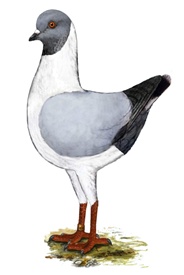 |
Blue Barless (-) Here the highest requirements at rounded figure and stand height as well as head can be placed. A pure pigeon-blue with primaries as dark as possible is required, whereby the 0.1 shows a sex-bound somewhat darker shield color, but not too cloudy. Pigeons with brownish primaries can't no longer obtain 93 points. The neck shape and -guidance is still to be improved. Especially the 1,0 are partly too strong in the neck. Also the neck should be straight guided. Furthermore it is importent to note, that partly the size of figur and leg thickness has reached the upper limit. |
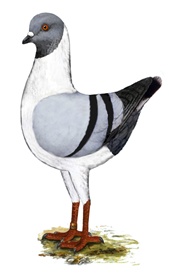 |
Blue with Black Bars (-) As with the Blue Barless the highest demands can also here be placed to figure, stand height and head points. But here we need to keep the size of figure "on eye". Far as color there are hardly nothing to complain about.The bars should be well seperated and long drawn. The wing position and back covering can partially be improved. |
 |
Blue Checker (-) Very good forms with matching neck- and stand length are available. Criticism are always to be found in the checkering image - either too open or too fully / tight. The ideal checkering is achieved by two well-seperated and sharply defined and not too large ovals in the upper part of the shield feather, and the feather tip must be sufficient blue. The color of the primaries should be as dark as possible. Rust deposits detracts into the rating. |
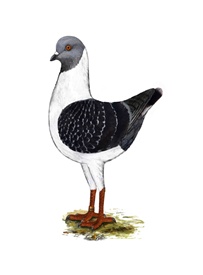 |
Blue Dark Checker (-) New color impact - also here very high requirements can be placed on figure and stand. They show the dense form of checkering. Here should the the tip of the shield feder only have an arrow pointing or have somewhat lacing drawing. Consequently, too much body color (blue) in the shield is here a fault. |
 |
Dark (-) Also a new color impact. On the shield the body color should be replaced and the shield color should therefore appear evenly dark. Individual brighter spots in the bow- or bar area are, if they are not too large in area, still to tolerate. |
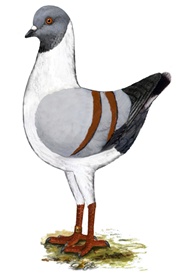 |
Blue with Bronze Bars (o)
Responding to form and stand length. Bar color is the eye-catcher. It is chestnut brown and pure, i.e. no peppery deposits (soot) and must at the tip be closed with af black lacing. If the bar color is too clayey, the highest rating can be 91 points. The shield color must necessarily be pure. Recently the eye ceres are causing problems - they must be dark and inconspicuous.
|
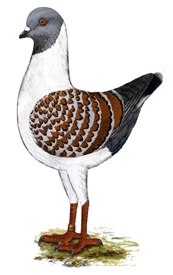 |
Bronze Tri (o) |
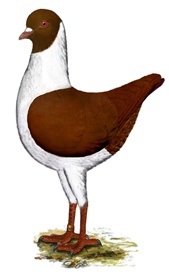 |
Red (-)
Short and rounded bodies as well as rounded heads are available. In the neck they should be slimmer and more elegant as well as more firm neck feather. We have requestment to a pure and rich red, and color in tail and primaries should not settle. The outer tail feathers must be maximized throughout-colored. A blue color in tail and ventral area is not to be tolerated. Furthermore you have to take care of a pure beak color, beak wattle and delicate eye ceres.
|
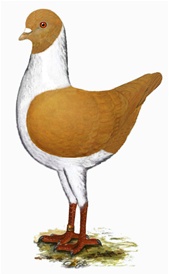 |
Yellow (-)
You can see short and round figures, appealing stand height and beautiful head points, but you have to take care of typically beak (incorporation and substance). What is desired is a bright yellow color. Color in primaries and tail should not settle. The outer tail feathers must be maximized throughout-colored. The soft resp. hairy bar feathers as well as loose neck feathers causes problems. There has to be worked for a more intense eye color.
|
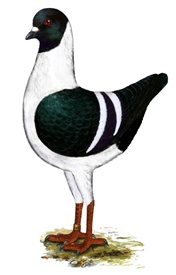 |
Black with White Bars (+)
Rarely shown color impact. Should in the body be shorter and rounder and at least a head with more substance. In this impact you have to make major concessions. The purity of color and bars should be classified according to our order of evaluation.
|
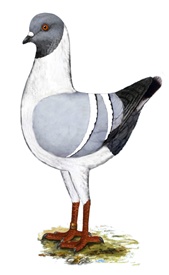 |
Blue with White Bars (+)
There exits only a few breeds, but the figures are quite good. There is also here to work on more substance in the heads. The bars should be as long and separated as possible and must end with a black lacing. Too jagged bars are unwanted. Furthermore, pay attention to dark eye ceres. |
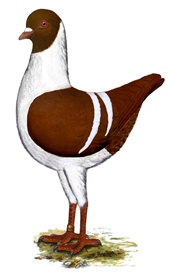 |
Red with White Bars (+)
Very rare color impact who has not been shown on the main special shows in the last 10 years. To work with this impact you have to prioritize the main racial characteristics, ie short body, round heads, matching stand height. Then come color and purity of bars.
|
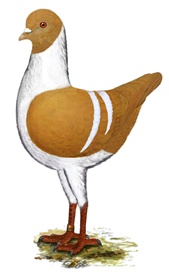 |
Yellow with White Bars (+)
As the foregoing it has not been shown on the main special shows in the last 10 years . Also here you have to supply large concessions in the main racial characteristics.
|
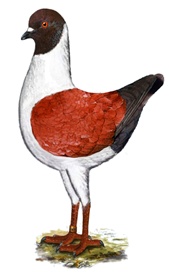 |
Bronce Clear (+)
Rarely shown color impact, but yet with quite a good body fullness. The heads should be fuller of substance. Color in head and tail corresponds to the laced variants. Color of primaries should be as dark as possible. Bronze deposits in primaries are color reserves. The shield color is required fawn (Deer-brown) and must not be too bright. Furthermore, the shield must be pure, i.e. without lacing. |
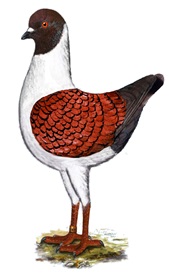 |
Bronce Laced (o) Small but stable collections are present. They show quite good breast width and -rounding, but should still be shorter in the back. Also stand height and neck nobility are still to be improved. Attention on a dark colored head. The color of shield must be chestnut and it makes few problems. The shield feather should become more broad and surrounded of a dark lacing. A blue outer lacing is faulty. Furthermore attention of inconspicuous (ie dark) eye ceres. |
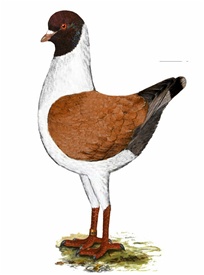 |
Sulphur Clear (+) Rare color impact that should be assessed with leniency. The exhibited animals should show more stand height and neck length. Bip and tail are blue-gray; the primaries are yellowish inside and dark to the end. The target is a light yellow and as possible a pure shield color. |
 |
Sulphur Laced (+) Also of rarely shown color impact, should also be evaluated with leniency. In stand height and neck length they should be improved. Bip and tail are blue-gray, the primaries are yellowish inside and dark to the end. At the lacing too high demands should not be required. |
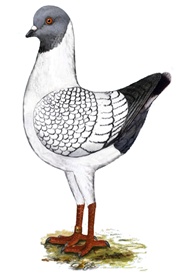 |
Blue Argent (+) Still rare and relatively young color impact. Priority in the main breed characteristics as consolidation of stand height and head rounding. Not too high demands to shield color and lacing should be provided. |
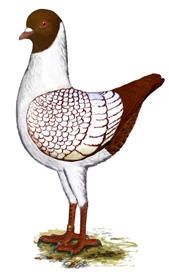 |
Red Argent (+) Rare color impact. Nevertheless show fairly good rounded figures, but should increase in stand height, neck length and head points. The bip, tail and ventral area should be red. The primaries should not be too bright and show sufficient color. Emphasis must be placed on broad shield feather with as conspicuous, encircling lacing. |
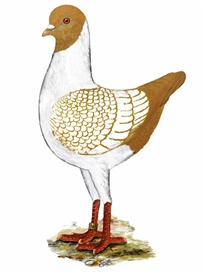 |
Yellow Argent (+)
Also as the aforementioned classified among the rarities. To be worked on a more shortly body, stand height and neck length. Bip, tail and ventral area have to be intensely yellow colored. The primaries must also show coloring. Finally, the shield drawing should be more clear. |
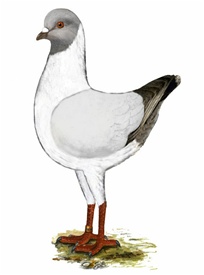 |
Silver Barless (o) Show quite good figures, stand height and neck length. Nevertheless, it should further on be worked on elegance and charisma. This also applies to the head rounding. Pay also attention to beak length and cere color. In coloring a smooth, bright and delicate blue silver is wanted. However primary and tail color must not be too bright, and should be satiated as possible. The tail shows a dark tail bar. |
 |
Silver with Dark Bars (o)
Good figures, matching stand height and neck length are present. However, they should also in type be more elegant. Color conditions the same applies as for the aforementioned. Attention must be paid on dark bars without rust deposits. |
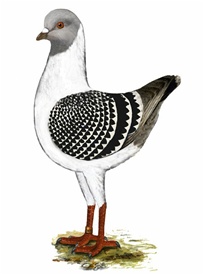 |
Silver Checker (o)
Figurative and color, they are quite well positioned. Great emphasisis on an even and clear checkering, not too full and not too empty, and without rust deposits. |
 |
Silver Dark Checker (o)
Newly added color impact, has not yet been shown on the main special shows. Figurative and color, the same as those for the Silver Checker. The body color should be replaced on the shield so far that only arrow pointed drawing or even lacing must be seen. Everything else can not be valid as Silver Dark. |
 |
Silver with Sulphur Bars (+)
So far, less shown color impact. Should be assessed with leniency. Nevertheless pretty good figures already exist. Basic color analogous to the aforementioned - showing sulphur colored bars having a dark lacing. |
 |
Silver Sulphur Checker (+) New color impact (approved in 2014) and so far the only Argent color impact. Figurative in this presentation process we can be quite satisfied with the animals. Now it is time to consolidate the type. On the shield feathers - on each side of the feather shaft - there is required a yellow ochre oval surrounded by a dark lacing. The feather end displays a triangle in the body color (blue silver). Have attention to broad shield feathers. We can only hope that this color impact will find his fans and not only a place in the color impact list. |
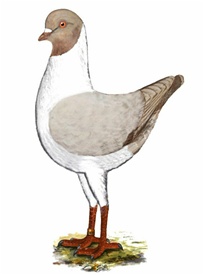 |
Russet Clear (o) The variant of Pale Brown has until now not been very apparent. The shield should show a bright even gray-brown color. Bip, tail and ventral area are darker. The color of primaries as gray-brown as possible. |
 |
Russet with Bronze Bars (o) Appears in a small but stable collection and figuratively fine. The stand height is still room for improvement. Working on a more elegant neck with firm plumage must be continued. An even color shield should be required. However, it should be noted that this color impact is fading by the sun, which makes it especially visible in the primaries, and therefore should be evaluated with leniency. The bar color should be reddish brown and finish with a dark brown lacing. Problems are the required orange-red eye color which really not is achievable - because of genetically conditioning. Even though this work should be done in this direction, and at least there should be a recognizable red ring around the pupil. A tendency towards a pure pearl eye must be rejected. |
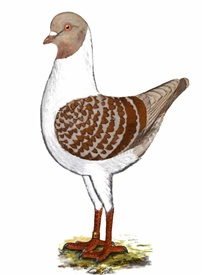 |
Russet Tri (o) Like their bar relatives also here found in rather small collections. Needs to be worked at more stand height and neck nobility. In color the same as those for the aforementioned. To get sufficient drawing image - like the other checkered - attention should be paid to a broad shield feathering. Attention: All 3 russet color impacts must show tail bar. |
 |
Mealy (-) Specious with short forms, good stand height and attractive head points. There must be worked on a pure shield color. It must not appear clayey. Head and bar color should match. Mouldy head color is a fault. Attention at color reserves in the insides of the primaries. Too bluish color from crossbreeding with blue or even ink stipper detracts into the rating (fault). |
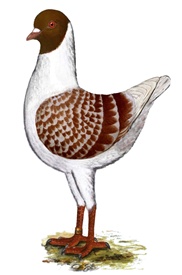 |
Red Checker (-)
Favour in type, figure and stand height. There is room for improvement in the neck guide and correct primary position. They are a little stronger colored than the Mealy with Red Bars. The approval of Red Dark Checker results, that the distribution of checkering has to be more heavily weighted. They should be more even and not too full and with more contrast. Too much shade of blue in the color scales back. Faulty are differently colored or dark stipper in tail and primaries. |
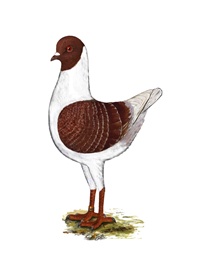 |
Red Dark Checker (-)
New color impact, figuratively are the same requirements to provide as by Red Checker. They should show the tight shape of checkering and still even just let recognize the sign of arrow point drawing or laced drawing. Faults as by Red Checker. |
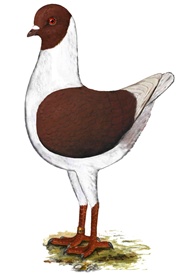 |
Dominant Red (-)
New color impact, figuratively equate the two aforementioned. Focus here is on the shield. Recognizable should only be drawing color. Any brightening or lacings are unwanted. Primaries and tail are brightened. Faulty are differently coloring or dark stipper in tail and primaries. |
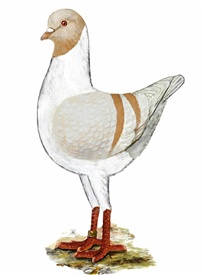 |
Cream (o) Are quite good in stand height and head rounding, but should partly be shorter. What is desired is an even yellow-cream colored shield. Bip and bar color are more intense. Primary and ventral area must not be entirely white, they must still show color. The other way round is to get too much blue tone out of the breed. Furthermore, different colored or dark stipper in tail and primary are faulty. |
 |
Yellow Checker (o) A more shortly body and neck nobility are to be improved. Look out for more even, high-contrast checkering (not too full) and broader shield feather. Faulty are differently colored or dark stipper in tail and primaries. |
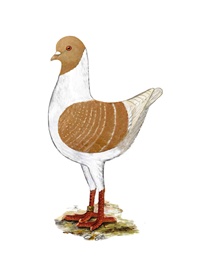 |
Yellow Dark Checker (o)
Figurative as aforementioned with the more satiated color of the checkering. Faults as aforementioned. |
 |
Dominant Yellow (o)
Similar to the Dominant Red this new color impact should show an even colored shield without brightening. Figurative the same expectations as to the Yellow Checkered. Faulty are differently colored or dark stipper in tail and primaries. |